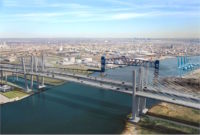Just a week after the chairman of the New York Metropolitan Transportation Authority warned of a possible budget crisis—one that would be the worst in 30 years—one of his former chief engineers told another industry audience of the subway and bus systems’ urgent needs.
Cosema Crawford, who left her post as chief engineer of the New York City Transit Authority last fall to join Louis Berger Group as senior vice president, noted that the 106-year-old subway system still has a signal system that is more than 50 years old. “It needs $20 million a year over 15 years just to catch up to a state of good repair,” she told members of the Transportation Research Forum’s New York chapter on Feb. 4.
Just a week before, Jay Walder, who rejoined the agency last July after a 19-year stint in London, had reminded attendees at a New York Building Congress luncheon Jan. 28 of the 1970s, when the New York City subways were a national symbol of urban decay.
Crawford echoed that warning, noting that for the first 50 years, fares were never raised from the initial 5 cents. By 1980, the lack of infrastructure investment had led to trains that traveled no more than 6,000 miles before failing, and a derailment occurring on average every two weeks.
Since then, the MTA has invested $71 billion in the subways and buses, and trains travel 200,000 miles on average before failing. Derailments are extremely rare, she said.
But current funding uncertainties are threatening the system’s improved status, she warned. “The MTA can rehabilitate about five stations a year” under its current rate of funding. But with 468 stations total, that isn’t fast enough to prevent deterioration.
Crawford noted that progress with implementing computer-based train control systems, which could improve train throughput by 21%, has been stalled due to funding uncertainty. The system, which includes transponders and computers, lessens the safety cushion of distance needed between trains. The system also needs more than $1 billion to centralize traffic control for a majority of its lines.
One thing the MTA’s infrastructure program isn’t lacking, however, is adequate pumps for heavy rainstorms, she added. When heavy rain flooded the subway tracks in August 2007, the system’s pumps had nowhere to divert the water—they had to wait for the city’s sewer pipes to clear up. “The water brings in garbage and dirt...that fouls up the circuits,” she noted. Workers had to clean up the debris by hand, and that also delayed reopening of tracks.
As a result, the MTA has begun installing architecturally designed water barriers on the streets of New York. Some include artistic coverings of subway gratings, and others include bicycle racks.





Post a comment to this article
Report Abusive Comment